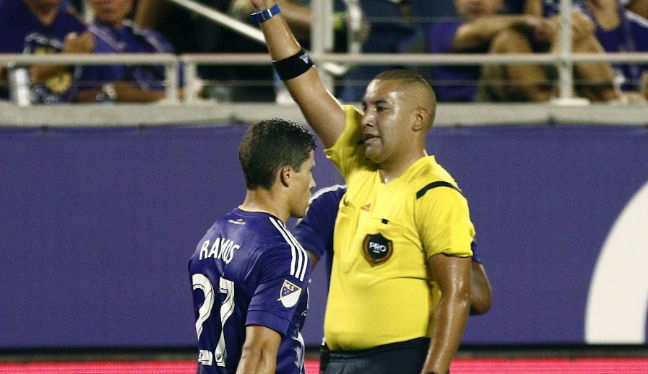Play of the Week 33: DOGSO and Penalty Area AR Positioning and Responsibility

By PRO Training & Development Manager Paul Rejer
In Play of the Week 33 we are examining a play from the Real Salt Lake versus Portland Timbers game, at 51:17, and the learning points that emerge from it. The incident covers DOGSO, a PK award, AR penalty area responsibility and, as always, positioning.
In this play Timbers’ Lucas Melano collects a long through-ball and has it fully under his control when he is moving towards goal with Salt Lake defenders, Jamison Olave and Aaron Maund in close pursuit.
Olave gets too close and trips Melano causing him to fall and lose possession of the ball, very close to the edge of the penalty area. Referee Juan Guzman has two decisions to consider.
Firstly, was this DOGSO, namely, denial of an obvious goalscoring opportunity? I make no apology for reminding ourselves of the criteria:
Referees should consider the following circumstances when deciding whether to send off a player for denying a goal or an obvious goalscoring opportunity:
– The distance between the offense and the goal
– The likelihood of keeping or gaining control of the ball
– The direction of the play
– The location and number of defenders
With Melano on the edge of the penalty area, he was a close enough distance to the goal. He had full control of the ball. The direction of play was towards goal.
Finally, the defenders were behind him and couldn’t make a fair challenge before he would have had his obvious opportunity. At this stage, referee Guzman would have had DOGSO in his mind.
The second question is: Did the foul take place inside or outside the penalty area?
From his position behind the players, Guzman would not have had a clue whether the offense took place inside or outsode the penalty area.
He therefore goes over to AR Jeff Hosking, who had already indicated a PK as he ran to the goal line, rather than stay level with the edge of the penalty area. It never does any harm to have dialogue, especially as Guzman had doubts, to check with his colleague on the PK award and the DOGSO.
Following the dialogue, Guzman correctly sends off Olave but incorrectly awards a PK as the offense took place outside the penalty area.
So how did they get this part of the play wrong?
When incidents occur close to the front edge of the penalty area, this has to be the ARs’ responsibility as they are looking across from the correct angle whereas usually, as in this case, the referee is looking from behind.
As discussed many times before in Play of the Week, in most cases errors are usually made due to incorrect positioning.
POTW: Click here to read previous Plays of the Week from Paul Rejer
If you look at Hosking’s position when the contact was made, instead of being square with the front edge of the penalty area, he was some five yards behind play and was looking from an incorrect angle.
Contact near the edge of the penalty area is always deceiving as by the time the offended player has fallen he is well inside the penalty area. Therefore, in this play, it was impossible for either official to know 100 per cent whether the offense took place inside or outside the penalty area.
When offenses occur near the edge of the penalty area, I believe players will not risk contact inside the penalty area but will tend to foul outside as it’s worth a gamble.
This again highlights the vital importance of positioning by ARs to make correct calls. Also the necessity of the modern day AR to be as fit as the players in order to be able to maintain correct positioning during a quick break of play.
